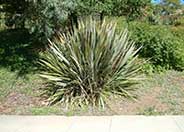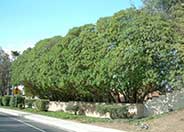
Common name:Myers Asparagus
Botanical name:Asparagus densiflorus 'Myers'
An evergreen groundcover, the 'Myers' also makes an excellent hanging basket plant when larger in size. Its formal looking fronds have an even, spiral arrangement of leaflets. It is damaged by severe frosts, and looks best with at least occasional watering.

Common name:Dusty Miller, Silver Groundsel
Botanical name:Senecio cineraria
The Dusty Miller exhibits growth to 1' or more, with velvet gray leaves that have broad, roundish lobes. Yellow flower heads appear through the middle of the plant during most months of the year. Cut heads back occasionally to encourage bushiness.

Common name:Kurrajong
Botanical name:Brachychiton populneus
Bottle Tree Kurrajong (Brachychiton populneus) is a large, evergreen tree native to Australia. It can reach 50’ tall and 30’ wide but has been planted and maintained in residential gardens to stay in the 20-30' height range. It is a very ornamental tree that has interestingly shaped leaves and clusters of white flowers that develop into seed pots that rattle in the wind. If this tree is selected for a small garden, it will require regular pruning and shaping to keep it to a desired size. The seed pots can also create a mess under the tree, so it is best to plant this tree in a location that can absorb the droppings. Once this tree is established, it requires very little water, so it is a great choice for drought-tolerant gardens. When it reaches a more mature size, leave the pruning to a licensed arborist to keep it looking and performing at its best. This tree should be planted at least five feet away from any hardscape areas, 10 feet from structures such as houses and buildings, and not near any powerlines. Shrubs and perennials should be planted about three feet away from this tree. It should be irrigated for about 45 minutes once a week when using most in-line drip irrigation systems.

Common name:Daylily (hybrid selection)
Botanical name:Hemerocallis hybrids
These summer-blooming perennials form clumps with large, grass-like leaves. Its showy flowers, resembling lilies, are borne in clusters on stems held well above the foliage. Daylilies can be found in many colors: yellow, orange, red, purple, pink or multi-colored. Hemerocallis does better in well-draining soil and with extra summer water. Hemerocallis are very hardy,with few or none pests/problems.

Common name:New Zealand Flax
Botanical name:Phormium tenax
New Zealand Flax is a large, bold plant with stiffly vertical, sword-like, green leaves that arise from its base. It should be grown under full sun for best color. Varieties will offer different growth habits and leaf color.
Maintenance Tips
Phormium tenax is a perennial that grows as a clump with strap-like leaves. This is a very popular plant and has many different hybrids that are selected for their different foliage colors, sizes, and textures. When growing this species, there is a lot of genetic variety, so the size of the mature plant can range from 2' up to 8'. To keep the maintenance as low as possible, plant in a location that is full sun, and well-drained and give it the space it needs to reach maturity. These plants are often the victim of poor pruning habits, with gardeners cutting the leaves off in the middle or shearing them because they are too large for the space they have been given. If this is the case, they should be transplanted to a location where they can reach their full size, or other plants around them should be moved out of their way.
Common name:Lavender Cotton
Botanical name:Santolina chamaecyparissus
This ground cover/small shrub will grow to 2' tall and has small, grayish silver leaves with yellow flowers that bloom in the summer.
Maintenance Tips
Santolina chamaecyparissus is a Mediterranean native that can be found in many California gardens. It is very drought tolerant and is very low maintenance if it is planted in a location where it can reach its full mature size of 2’ tall to 3’ wide. This plant is susceptible to root rot or fungal diseases if the soil is too wet or doesn’t drain easily. If the plant develops fungal issues, allow the soil to dry out and treat with a systemic fungicide. This plant usually blooms in the summer, and the plant will continue to bloom if you deadhead the spent flowers. In the late winter or early spring, you can cut back the foliage by one-third of the current size to maintain the size and encourage new growth.
Common name:Fox Tail Agave, Velvet Agave
Botanical name:Agave attenuata
This Agave has a dramatic tropical form. Even light frost can damage its succulent leaves. It is great for containers. In the low desert, partial sun will be best. If it becomes top heavy, simply cut and stick in the ground to root. It is not a fast grower and has light green foliage. It will also die after flowering but pups around the mother will survive. Distinctive with its large rosette of leaves perched on a long curving trunk, it is a native from Mexico.

Common name:Hidcote English Lavender
Botanical name:Lavandula angustifolia 'Hidcote'
This is a slow growing lavender that grows to 2-3' tall with deep purple flowers. It is drought tolerant and attracts hummingbirds and butterflies.
Maintenance Tips
Lavandula angustifolia 'Hidcote' is a smaller hybrid of the English Lavender and is often found in California native gardens. It is a woody shrub with a nice round form. It grows 2-3’ tall and wide and has flower stalks that emerge above the foliage in the spring. The foliage and blooms are very fragrant and are a magnet for bees and butterflies. To keep the maintenance as low as possible, plant it in a sunny location with the space to reach its full mature size. Once the flowers have faded, the spent stalks can be deadheaded to keep the shrub looking tidy and encourage additional flowers. This shrub can take a more aggressive hedging, cutting back by about a third in the winter to keep the round shape.
Common name:Myoporum
Botanical name:Myoporum laetum
This evergreen shrub/tree will grow quickly to 30' tall and 20' wide. It has narrow, dark green leaves with small, white flowers that bloom in the summer and are followed by reddish purple fruit. This is a good coastal plant.

Common name:Butterfly-Iris, Fortnight Lily
Botanical name:Dietes iridioides
This clumping evergreen Iris bears tall, narrow leaves to 30" tall and white flowers marked purple in the center on stalks up to 3' tall. This variety has stiffer, darker foliage than the bicolor form. It requires sun to part shade with little or no summer watering when established.

Common name:Purple Hopseed Bush or Hop Bush
Botanical name:Dodonaea viscosa 'Purpurea'
This fast-growing shrub has an upright, branching habit that reaches a height of 12'-15', with willow-like leaves that are 4" in length. Its foliage is bronzy-green in color, which turns a reddish-purple shade in the fall and winter. It has compact growth and requires full sun for the best results.

Common name:Purple Hopseed Bush or Hop Bush
Botanical name:Dodonaea viscosa 'Purpurea'
This fast-growing shrub has an upright, branching habit that reaches a height of 12'-15', with willow-like leaves that are 4" in length. Its foliage is bronzy-green in color, which turns a reddish-purple shade in the fall and winter. It has compact growth and requires full sun for the best results.
Designer: California Native Garden
Photographer: GardenSoft
Maintain a two to four inch layer of mulch on the soil surface to reduce weeds, infiltrate rain water, and reduce compaction.
Mulching and adding compost to soil can minimize evaporation and help soil absorb and store water.
Drip and other smart irrigation delivers water directly to roots, allowing no excess water for weeds.